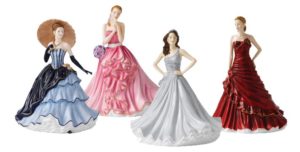
The Royal Doulton Company is a world-renowned English pottery company producing collectibles and tableware. It originated in London in 1815 and expanded its size and reputation through both acquisition and organic growth. Today its products include porcelain, collectibles, dinnerware, glassware, giftware, jewelery, linens and more.
Three key brands now comprise what is called Doulton Home; they are Royal Doulton, Royal Albert, and Minton. Doulton Home is now part of the Waterford Wedgwood group and most of the current production for these three brands is performed outside of the United Kingdom, in the Far East and Indonesia.
History
The Royal Doulton company takes its name from John Doulton. John Doulton, born in Fulham in 1793, learned his trade at the Fulham Manufacturing Company, well known as one of the first English commercial producers of stoneware, founded by master potter John Dwight in 1688. John Doulton completed his apprenticeship, earning a reputation as one of the best pot throwers in London.
John Doulton then joined forces with Lambeth Pottery owner Martha Jones and foreman John Watts to form Jones, Watts and Doulton in 1815. This factory was a tiny pottery located in Vauxhall Walk, Lambeth, a borough of London, England. The factory specialized in producing utilitarian salt glazed stoneware, similar to the Fulham factory.
Martha Jones broke ties with the company in 1820 and by 1826, now trading as Doulton & Watts, the company moved to larger premises in Lambeth Walk to cope with the rapid expansion it was experiencing.
In 1835 Henry Doulton, the second son of John, joined the firm, at the age of 15. He had a great aptitude for all aspects of pottery making and was soon making major contributions to the business.
In 1846, in response to greater health awareness and the need for glazed piping to replace the older porous brick sewers, Doulton built a pipe factory on what was to become the Albert Embankment. The demand for these products was tremendous and within three years Doulton founded factories in Dudley and St Helens to meet the need for pipes and other sanitary ware.
John Watts retired from the company in 1854. At this time, trading now as Doulton & Company, John Doulton began experimenting with a more decorative pottery line. Many glazes and decorative effects were developed including faience, impasto, silicon, carrara, marqueterie, chine, and rouge flambe.
By 1871, Henry Doulton had launched a studio at the Lambeth pottery and offered work to designers and artists from a local art school. Their names included Frank Butler, Mark Marshall, Eliza Simmance, J. McLennan, John Broad, W. Rowe, George Tinsworth and the Barlow family (Florence, Hannah, and Arthur). Henry was responsible for new technological innovations to the production of ceramics including a steam driven potters’ wheel, which put the Doulton business ahead of its competitors by some ten years. Henry took full control of the company upon the death of his father, John, in 1873.
In 1882, Doulton purchased the small factory of Pinder, Bourne & Co, at Nile Street in Burslem, Staffordshire, which placed Doulton in the region known as The Potteries. Pinder, Bourne & Co. was well known at the time for their fine bone china. Doulton art director John Slater recognized the growing trend toward gleaming porcelain pieces in brilliant colors, and he saw this new acquisition as an opportunity to move aggressively into these enamel on glaze decorations.
By 1885, Doulton was producing world-class wares for an international clientele. Doulton won honors at major international exhibitions and was producing a tremendous variety of figurines, character jugs, vases and other decorative pieces in vibrant colors and using both under- and on-glaze enameling techniques. Doulton products also came to the attention of the British Royal family. Queen Victoria was so impressed with his wares that she knighted Henry Doulton in 1887 for his innovative contributions to ceramic art, and in 1901 King Edward VII bestowed upon the Burslem factory the Royal Warrant as well as allowing it to adopt its new name, Royal Doulton.
When Sir Henry died in 1897, Henry’s son Henry Lewis Doulton took over control of the company. The company continued to hire talented artists including the next art director Charles Noke, Harry Tittensor, Joseph Hancock, and many others.
The company continued to add products during the first half of the 20th century while retaining its reputation as a prime manufacturer of fashionable and high-quality bone china. The 2 world wars halted production temporarily but in between the wars new pipe works were established at Erith in Kent in 1925 (when production of pipes moved from the Lambeth site), a 1935 acquired pottery near Tamworth became the site for manufacture of electrical insulators and specialist chemical resistant ware and sanitary work slowly moved to Whieldon near Stoke-on-Trent in 1937.
After World War II, production emphasis shifted to simpler designs, which could be mass produced at more affordable prices. Another renowned art director, Jo Ledger, joined the company in 1954, and continued producing older designs while at the same time exploiting the newer techniques that allowed Royal Doulton to produce high quality works at modest prices.
The Lambeth factory finally closed its doors in 1956, due largely to new clean air regulations that prevented the production of saltglaze in the urban environment. Doulton figures were made at the Burslem plants from 1890 until 1978.
On September 30, 2005, Doulton’s Nile Street factory closed after being sold to developers. The majority of Doulton pieces are today made in Indonesia, although the higher-quality items are still made in England at the home of parent company Waterford Wedgwood in Barlaston, in the countryside south of the Potteries.
Royal Doulton is now part of WWRD Holdings Ltd. Some items are now made in the parent company, WWRD Holdings Ltd in Barlaston, south of the Potteries Conurbation. Further production is carried out in Indonesia. On 11 May 2015, in a deal expected to close July 2015, the Fiskars Corporation, a Finnish maker of home products, agreed to buy 100% of the holdings of WWRD.[5] On 2 July 2015 the acquisition of WWRD by Fiskars Corporation was completed including brands Waterford, Wedgwood, Royal Doulton, Royal Albert and Rogaška. The acquisition was approved by the US antitrust authorities.
Acquisitions and the Pearson Interregnum: 1968-93
The year 1968 saw the first series of acquisitions by Doulton & Co. It first purchased the world-renowned Minton China, a company founded by Thomas Minton in 1793. Minton dominated the industry during the middle of the 19th century and the company’s innovations included the acid gold decorating process, the majolica-type body, the pâte-sur-pâte relief decoration technique, encaustic tiles, and Parian statuary. In the same year, Doulton acquired Dunn Bennett, a company founded in 1876 when Thomas Wood-Bennett joined his father-in-law William Dunn to begin potting, concentrating on hotelware. In 1969, Webb Corbett and Beswick became part of the Royal Doulton group. Webb Corbett was founded in 1897 to make English full-lead crystal; Beswick traced its history to 1890, when James Wright Beswick and his son began producing both table and ornamental ware. The hand-cut crystal of Webb Corbett later would be rebranded under the Royal Doulton name.
Orrok Sherwood Doulton’s sons, Mark and Michael, both joined the company. Michael Doulton joined the company in 1970, working under a fictitious name while learning the different aspects of pottery production. Starting in 1976 he began acting as traveling ambassador for the company and with the formation of the Royal Doulton International Collectors Club, a group dedicated to the collection and preservation of Royal Doulton products, he served as honorary president beginning in 1980. Although the Doulton family remained an important and integral part to running the business, leadership extended outside the family in later years.
The greatest merger in the history of ceramics came in 1972, when Pearson PLC purchased Doulton & Co. Pearson had a controlling interest in Allied English Potteries and combined the two tableware groups under the Royal Doulton Tableware name. Pearson’s emergence in the pottery industry came about almost by accident. Originally, the Pearson empire was concerned mainly with construction engineering and the development of oil fields. But after investing money into a struggling business called Booth’s pottery during the 1920s, Pearson eventually became the controlling shareholder. Then, 20 years later, Pearson began increasing their pottery interests. In 1944, the company bought Colclough’s of Longton, a business founded in 1893 that made moderately priced bone china teaware. Pearson combined its Booth pottery with that of Colclough’s, forming a new entity called Booth and Colclough. In 1952, Pearson acquired the Lawley Group, a company controlling a national chain of specialist china and glass retailers and pottery manufacturers, including Ridgway and Adderly. Seven years later they purchased Swinnertons and Alcock, Lindley and Bloor, manufacturers of redware pots. Other names joining the group were Royal Crown Derby, Royal Albert, and Paragon. Royal Crown Derby, a luxury brand, traced its roots back to 1750 and founder William Duesbury; it was the oldest surviving maker of English porcelain. Founded in 1896, Royal Albert was a tableware maker whose “Old Country Roses,” introduced in 1962, was one of the best-selling bone china patterns of all time.
In 1974, Royal Doulton revived the concept of its original Lambethware, creating a casual tableware with a country charm and practicality, being oven and freezer proof and unaffected by detergent or the dishwasher. Royal Doulton Tableware Limited grew to represent approximately one-third of the entire British tableware industry.
Also during the period of ownership by Pearson, Royal Doulton management focused on achieving a greater degree of efficiency at its facilities. From 1987 to 1990, the company spent £10 million (approximately US$16.4 million) annually to automate and mechanize its factories, resulting in even finer quality and manufacturing flexibility. The company maintained a dozen factories producing all types and grades of product at that time.
Independent But Struggling: Mid-1990s and Beyond
Pearson began focusing more on its media interests in the 1990s and divested many of its other holdings. Royal Doulton plc was thus spun off from Pearson in December 1993 and was listed on the London stock exchange; according to analysts, the company had a market value of between £150 million and £200 million at the time.
Under the leadership of Stuart Lyons, Royal Doulton returned to a strategy of acquisition in its initial years as a newly independent company. During 1996 the firm acquired Holland Studio Craft and Caithness Glass, the latter for £5.5 million. Holland Studio had been founded in 1986 as a producer of collectible cold-cast resin sculptures. Among the subjects of these sculptures were dragons, wizards, frogs, bears, and pigs. Established in Scotland in 1961 as a maker of art glass, Caithness Glass expanded into paperweights in 1969 and soon gained a world-class reputation for the production of high-quality abstract paperweights. Another development in 1996 was the start-up of production at a new manufacturing plant in Indonesia. With sales of fine china stagnant, this new facility was key to the company’s strategy of expanding production of casual tableware for two of the company’s core export markets, the United States and Japan. The new facility also was designed to counter the effects of high U.K. labor costs. Overall sales were flat in 1996, increasing just four percent to £251.8 million.
The situation at the company soon worsened. Lyons resigned suddenly in May 1997, after 12 years at the helm, following a failed acquisition of a large U.S. fine china company whose identity was not revealed. The botched takeover cost Royal Doulton £1.6 million in advisers’ fees. Further acquisitions were put on hold as the new chief executive, Patrick Wenger, a 37-year company veteran, concentrated on turning around the company’s core business. A restructuring was launched that included a workforce reduction of 330 because of the closure of its St. Mary’s factory in Stoke-on-Trent as well as a restructuring of the group into six product divisions–tableware, giftware and collectibles, crystal and glass, hotel and airlines, prestige products, and licensing–each headed by its own managing director. Saddled with too much inventory, Royal Doulton drastically reduced its range of products, cutting the number of tableware patterns from 320 to 120 during 1997. Extraordinary charges totaled £11.6 million in 1997, leading to a net loss of 1.8 million for the year. Turnover, meantime, barely increased, resting at £252.2 million.
Continued inventory overstocking, production overcapacity, and high debt levels combined with the economic turmoil in Asia to further batter Royal Doulton in 1998. In the midst of a year in which sales declined 5.3 percent to £238.8 million (US$396.1 million), Hamish Grossart was appointed nonexecutive chairman in May. Grossart was an accountant by training who had gained a reputation as a corporate turnaround artist. Within months of his appointment, he was serving as acting chief executive following the involvement of Wenger in a serious automobile accident in Australia in November that left him unable to return to his management duties. In December, Royal Doulton announced a fundamental restructuring program involving the cutting of a further 1,200 jobs (or nearly one-fifth of the remaining workforce), the consolidation of three warehouses into one, a temporary closure of most of the company’s U.K. factories, a further writedown of inventory, and the closure of some underperforming retail outlets. Overall, the company was aiming to reduce the number of product lines it produced from 48,000 to fewer than 20,000 over the four years that Grossart estimated it would take to complete a turnaround. Needing to modernize its product styles, it also was working to speed up the development of new concepts, attempting to reduce the time from design to market from two years to six months. Charges related to the restructuring added up to £47.7 million, resulting in a net loss for 1998 of £45 million.
In August 1999 a secondary stock offering raised £31.3 million. This fresh infusion of cash helped Royal Doulton reduce its net indebtedness from £43.6 million to £17.8 million over the course of 1999. The company was far from a turnaround, however, as sales declined a further 20 percent, to £190.3 million (US$307.6 million). About £11 million of the reduction represented sales that were lost because of interruptions in deliveries caused by the bungled implementation of new warehouse software being installed to meet Y2K compliance. Other reasons for the sales decline were the continued economic problems in Asia and the closure of an additional 61 underperforming retail outlets, including both stores and concessions within department stores. A further threat emerged in November 1999 when arch-rival Waterford Wedgwood plc acquired a 15 percent stake in Royal Doulton on the open market for £11.1 million. Waterford termed the transaction a “strategic investment” and not a prelude to an outright bid, but nevertheless declined to rule out a future bid if a rival takeover company emerged. For 1999, Royal Doulton posted a net loss of £34.6 million (US$55.6 million), including a restructuring charge of £9.1 million.
At the beginning of 2000, Wayne Nutbeen was promoted to chief operating officer, taking over day-to-day management duties from Grossart, who remained chairman. Nutbeen had worked for Waterford Wedgwood from 1988 to 1996, when he was hired away by Royal Doulton to head up the company’s Australian subsidiary (Nutbeen, in fact, had been in the accident in Australia that ended the career of Wenger). Nutbeen then became head of Royal Doulton’s North American operations at the beginning of 1999. Disposals marked the first six months of 2000. The head office in Stoke-on-Trent was sold. In addition, the venerable Royal Crown Derby porcelain subsidiary was sold to a management-led group for £16.5 million as the company continued to scale back its exposure to the higher ends of the market (Royal Doulton would, however, continue to distribute the brand). These moves helped cut pretax losses for the six months to June 30 from the £14.4 million figure of the previous year to £1.3 million. Sales were down 3 percent, a vast improvement over the year-earlier result. Although it was too early to declare the consummation of a turnaround, and a takeover by Waterford or some other firm was still a distinct possibility, Royal Doulton clearly had made much progress on its road to recovery.
Principal Subsidiaries: Royal Doulton (UK) Limited; PT Doulton Multifortuna (Indonesia; 70%); Caithness Glass Limited; China Millers Limited (50%); Royal Doulton Australia Pty. Limited; NV Royal Doulton (Europe) SA (Belgium); Royal Doulton Canada Limited; Royal Doulton Hong Kong Limited; Royal Doulton Japan KK; Royal Doulton Benelux B.V. (Netherlands); Royal Doulton USA Limited.
Principal Competitors: Corning Incorporated; Dansk, Inc.; Department 56, Inc.; Fitz and Floyd, Silvestri Corporation Inc.; Lenox, Incorporated; Mikasa, Inc.; Noritake Co., Limited; Oneida Ltd.; Spode Limited; Tiffany Co.; Villeroy Boch AG; Waterford Wedgwood plc.
The three main ingredients for Royal Doulton wares include cornish stone, china clay, and calcined bone ash. This results in a translucent, but strong body. More than 2000 different figures have been produced by Royal Doulton over the years. Doulton’s Rouge Flambe (veined sung) is high glazed, strong colored wares noted for its fine modeling and exquisite colors used in the animal items in the line.
Serial wares
Some of the more prominent and popular figures are serial wares. For instance, the Gibson Girl series by Royal Doulton was introduced in 1901 (plates). The series was drawn by Charles Dana Gibson.
Dickensware pieces by Royal Doulton were produced, based on the writings of Charles Dickens, from 1911 to the early 1940s.
The Robin Hood series by Royal Doulton was introduced in 1914 based on the famous tale of the hero and his merry men.
Works based on Shakespeare’s characters resulted in two series of production items by Royal Doulton. Shakespeare’s series #1 portrays scenes from the plays were made from 1914 until World War II and Shakespeare’s series #2 was made from 1906 until 1974 featuring decorative characters from the writings.
The Nursery Rhymes series were first produced in earthenware in 1930 and later in bone china and have become a very popular Royal Doulton line.
The Bunnykins series were produced from 1933 for children and over 150 bunnykins scenes have been designed. The most valuable Bunnykins pieces were signed by artist Barbara Vernon for Royal Doulton.
Value:
The value of a figurine is determined by how perfect (or imperfect) it is. A hairline crack makes most figures virtually valueless. Paint chips, crazing, breaks or missing parts also severely diminish value. Restored figures are also diminished in value. Early hand painted figurines often had small splashes or over-brush of paint. This does not detract from value and may even add character to a figurine.
Small firing ‘specks’ sometimes are seen in figurines as well. This sometimes is undesirable, but not always as it is a factory speck. Usually one can feel a ‘bump’ like a grain of sand with the fingernail, but the bump is glazed over so it indicates that’s the way it came from the factory.
A good way to check your figurine for defects is under a bright light. If a scratch or crack appears and it is rough under the fingernail it is probably post manufacture damage. ‘Crazing’ or spiderwebing appears on some very early items after many years. This is especially prevalent in non bone china figures such as earthenware. On a bone china figurine, a crazing effect can be due to the figurine receiving a hard knock or drop at sometime in its existence.
I use a blacklight on all figures to determine if a restoration was ever done as well. These are just a few of the tricks of the trade in determining the quality of a figurine.
Most valuable
The pieces with a limited production run, those signed by an artist, or those pieces marked “Potted” (indicating a pre-1939 origin) are highly collectible and perceived to be more valuable than other pieces of Royal Doulton. Wares made after 1920 were marked with a lion (with or without a crown accompanying the lion) over a circular Royal Doulton mark.
Counterfeits.
Every once in a while, a counterfeit figurine is found. An expert can easily spot them as they just do not look quite right. Although a counterfeit is rare, it’s best to have an expert determine this.
By knowing the exact size a figure is supposed to be and how the coloring is and the overall look, quality and glaze, one can spot a fake. Sometimes the only way I determined it was a fake was the size and a few other indicators. Counterfeits are not a big concern as there are few of them.
Royal Doulton Marks and Backstamps
In 1872, the “Royal Doulton” mark was used on all wares from the company. The Royal Doulton mark has been used since 1902 and is still in production today. In 1912-13, Charles Noke launched a new group of Royal Doulton figures. The first figure was HN1, “Darling” in honor of Queen Mary.
Beginning in 1913, a HN number was used on all wares. This HN number refers to artist/designer Harry Nixon of Royal Doulton. Harry Nixon was an artist in charge of painting the figures. Other artists included John Sparkes, George Tinsworth, Arthur Barlow, and Agnete Hoy among others. The HN numbers were chronological until 1940, after which time blocks of numbers were assigned to each modeler of the figures.
From 1928 to 1954, a small number was placed to the right of the crown’s mark on all items made between those years. This number (the one at the right of the crown’s mark) when added to the year 1927 will give you the year of manufacture of a particular piece.
Most collectors like to know when their Royal Doulton figures were made. Sometimes it is possible to identify the exact year of manufacture, but in most cases it is only possible to be accurate within a band of likely dates.
In the 1930’s doulton had decided that they would start registering there designs to stop them being copied. They registered then with the UK patent office and often resulted in registration number id printed underneath the backstamp. The year the jug was registered can be worked out from the table numbers published with the patent office. Most cases registration was a year before the jug went into production. It should be noted to all buyers and collectors that the registration number does not give the date of manufacture for a specific piece but only when the design was first protected.
A date coding system was introduced in the late 1920s. The coding was very simple and it is the only way of being sure of a figure’s exact year of manufacture. The coding consisted of a numeral being printed beside the Royal Doulton backstamp. By adding this number to the base year, 1927, the year of manufacture can be obtained. Roman Numerals were used until 1930 and Arabic numerals thereafter. However, this date coding system seems to have been discontinued by the 1950s.
Sometimes it is possible to detect other numbers impressed in the base of some figures. One set of numbers will be the model number (not the same as the HN number), and another set of numbers will look like a date (e.g. 2.32). The latter number is a date, but not necessarily the date the figure was made. It is the date that the mold from which the figure was cast was made. As molds quickly wear out, this date is more than likely to be the same date as the date of manufacture.
Royal Doulton has changed the style of marking their figures on a number of occasions over the years. The Royal Doulton “lion and crown” mark has remained more or less constant, but the form in which other information is presented has changed. By knowing the production dates of a particular figure and also the dates the markings changed, it is possible to be a little more specific as to the year of manufacture. It is worth remembering that although it is often stated that certain pre-war figures ceased production “by 1949”, production often ended long before this date. The year 1949 was taken as a convenient cut off point, but in fact figure production was phased out rather than coming to a halt as the war time restriction of decorative china production took hold. Therefore some figures introduced in the mid to late 1930s had a very short production run. Many were discontinued as early as 1940.
The Royal Doulton Stamp is an important piece of information when you are deciding to purchase, bid or make an offer for.
This is what you need to know: From 1902 to 1920, Royal Doulton had the HN number, the figurine name, and any artist identification of style Hand Written with the Log saying only Royal Doulton England. From 1920 to 1930 the HN number, figurine name and style were still hand written, but the logo now says Made In along with Royal Doulton England. From 1932 until 1945, the figurine name is printed along with registration number, but the HN number is still hand written and the the works Bone China is added to the logo. From 1945 until 1959 the markings are the same as from 1932 – 1945, but the painters initials are added hand written and the logo crown has more spikes. From 1959 till present day, the logo crown is back to 5 points and the figurine name, HN number, and registration numbers are all printed. The only way someone can tell you the exact date a figurine was made is if a small number is directly to the right of the logo crown, then add that number to 1927 and you will know the exact date made.
In 1920, Mr Leslie Harradine joined Doulton and was the primary designer for many years. By the 1950’s to the 1970’s, nearly all the figures were modelled by Peggy Davies who specialized in Pretty Ladies figurines and Mary Nicholl who contributed to many of the Character series.
Copyright and Registration numbers.
Copyright dates found on most figures mean that is when the figure model was copyrighted, generally production began one year after the copyright date.
Mid 20th century figures also carried a Registration number which was later discontinued. For example: A figurine called Top o’ The Hill may bear a copyright date of 1936, but that figure was produced from 1937 thru 2004, so the copyright date on the backstamp does not mean it is from 1937 necessarily. It is likely a much more recent production figure. If the item has a series of registration numbers on the backstamp it is circa mid-20th century. There’s many ways of estimating very early figurine manufactured dates. An expert can help.
1879 – 1902: Adapted from a similar Lambeth mark which incorporates four interlocking “D’s”. Introduced c. 1882. After 1891, the word “England” was added beneath. Continued until 1902.
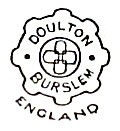
Similar to above, introduced c.1882. After 1891 the word “England” was added underneath, as in the above example. Discontinued in 1902.
 1885 – 1902: Coronet added c. 1886 marking the appointment of Henry Doulton as Potter to His Royal Highness King Edward VI. England dded beneath 1891. Used on more expensive earthen wares and bone china. Variations do exist.
1885 – 1902: Coronet added c. 1886 marking the appointment of Henry Doulton as Potter to His Royal Highness King Edward VI. England dded beneath 1891. Used on more expensive earthen wares and bone china. Variations do exist.
 1882 – 1912 Devices incorporating the name of the pattern”Rouen” – Crown used c. 1886
1882 – 1912 Devices incorporating the name of the pattern”Rouen” – Crown used c. 1886

Used on “Kew” Pattern table ware

1895 – 1903 – 1915 Used on Holbein Wares. Dating is not accurate.
![]() 1885 – 1939 The Slater – Doulton patent was used on Chine` and Chine`-gilt wares. The process involved the use of Linen to impress clay and decorate with glazes and gilt.
1885 – 1939 The Slater – Doulton patent was used on Chine` and Chine`-gilt wares. The process involved the use of Linen to impress clay and decorate with glazes and gilt.

A special mark used on “Morrisian” ware dedicated to the Morrisian dancers.

A special mark used on early small Flambe` wares
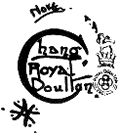
1925 – 1940 Chang script mark. C.J. Noke’s signature and Harry Nixon’s monogram.
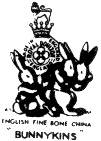
Mark used on “Bunnykins” nursery ware

1916 – 1933 “Titanian” wares for small items
 1930 – 1942 “Brangwyn” wares
1930 – 1942 “Brangwyn” wares

Chinese Jade script mark. C.J. Noke’s signature and Harry Nixon’s monogram
 1905-1956
1905-1956
 1922-1956
1922-1956
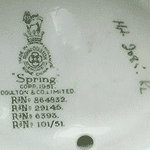 1945 – 1959. The backstamp consists of a printed title (often in quotation marks) and design registration numbers. In addition, a copyright date and the words “DOULTON & CO. LIMITED” are added. Often a hand-written HN number is also found.
1945 – 1959. The backstamp consists of a printed title (often in quotation marks) and design registration numbers. In addition, a copyright date and the words “DOULTON & CO. LIMITED” are added. Often a hand-written HN number is also found.
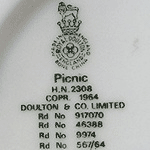
1959 – 1976. This backstamp consists of a printed title and HN number (in a smaller and neater type face), design registration numbers, a copyright date, and the words “DOULTON & CO. LIMITED”.
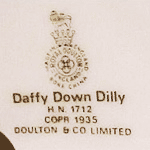
1977 – 1978 . This backstamp is the same as the previous mark, however, the registration numbers are removed.
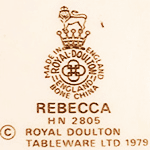
1979 – 1981. This backstamp consists of a printed title and HN number in uppercase type. In addition, the words “© ROYAL DOULTON TABLEWARE LTD.” are added.
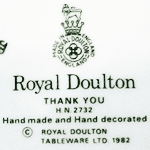 1982. This backstamp consists of a printed title and HN number in smaller uppercase type. The words “Hand made and Hand decorated”are added, along with the words “© ROYAL DOULTON LTD”. In addition, a printed “Royal Doulton” is added below the mark.
1982. This backstamp consists of a printed title and HN number in smaller uppercase type. The words “Hand made and Hand decorated”are added, along with the words “© ROYAL DOULTON LTD”. In addition, a printed “Royal Doulton” is added below the mark.
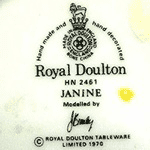 1983. This backstamp consists of a printed mark, a title in larger print than the previous mark, and the HN number above the title. The words “Hand made and Hand decorated” appear in semi-circular form around the Royal Doulton mark. In addition, a facsimile signature of the modeller is added. The words “© ROYAL DOULTON TABLEWARE LIMITED” also appear.
1983. This backstamp consists of a printed mark, a title in larger print than the previous mark, and the HN number above the title. The words “Hand made and Hand decorated” appear in semi-circular form around the Royal Doulton mark. In addition, a facsimile signature of the modeller is added. The words “© ROYAL DOULTON TABLEWARE LIMITED” also appear.
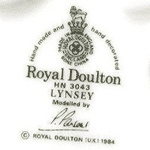 1984. This backstamp is the same as the previous backstamp, however, the words “© ROYAL DOULTON (UK)” replace “© ROYAL DOULTON TABLEWARE LIMITED”.
1984. This backstamp is the same as the previous backstamp, however, the words “© ROYAL DOULTON (UK)” replace “© ROYAL DOULTON TABLEWARE LIMITED”.
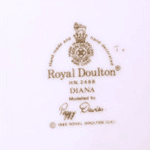 1985. This backstamp is the same as the previous backstamp, except the registered trade symbol is added to the words “Royal Doulton” under the Royal Doulton mark.
1985. This backstamp is the same as the previous backstamp, except the registered trade symbol is added to the words “Royal Doulton” under the Royal Doulton mark.
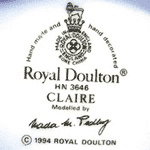 1986 – 2002. This backstamp is the same as the previous backstamp, however, the words “© ROYAL DOULTON” replace “© ROYAL DOULTON UK”.
1986 – 2002. This backstamp is the same as the previous backstamp, however, the words “© ROYAL DOULTON” replace “© ROYAL DOULTON UK”.
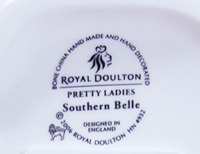 2002-current.
2002-current.
Source: wikipedia.org
